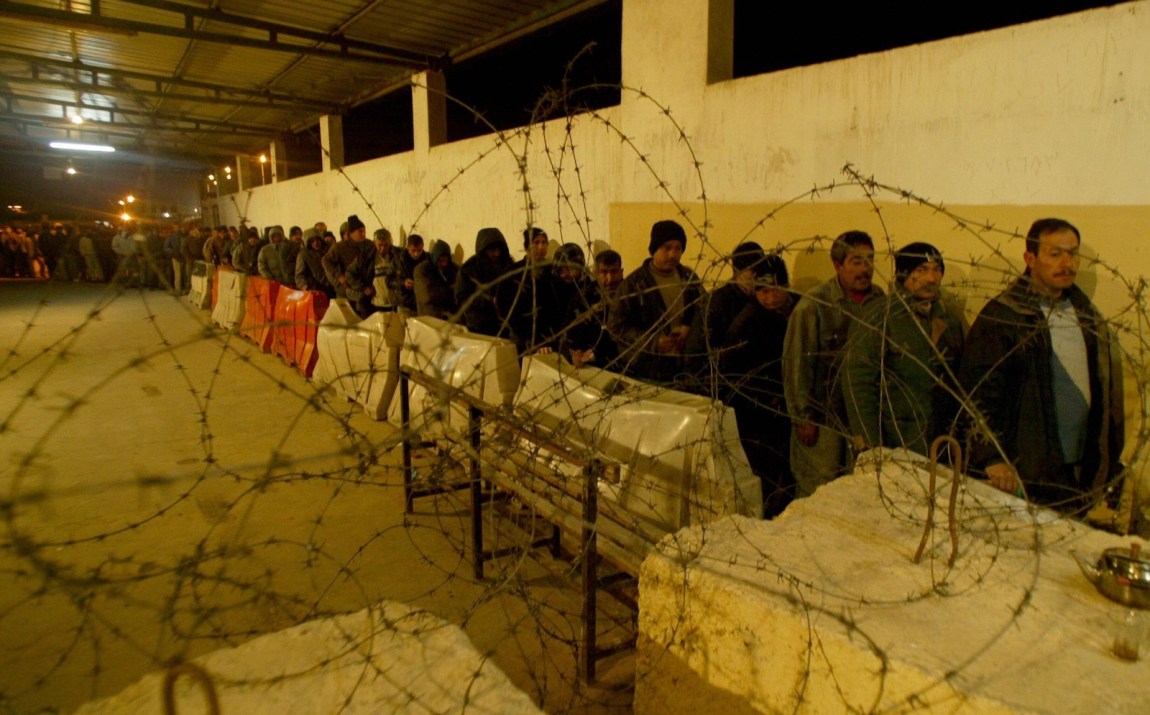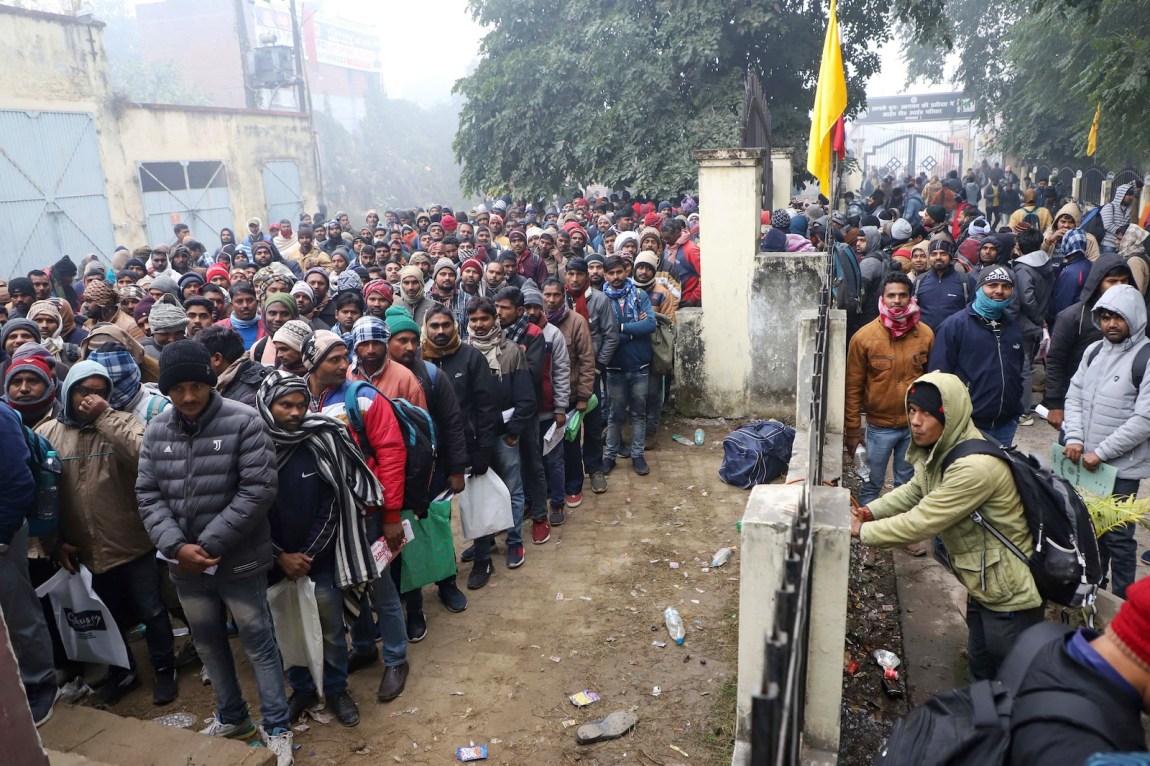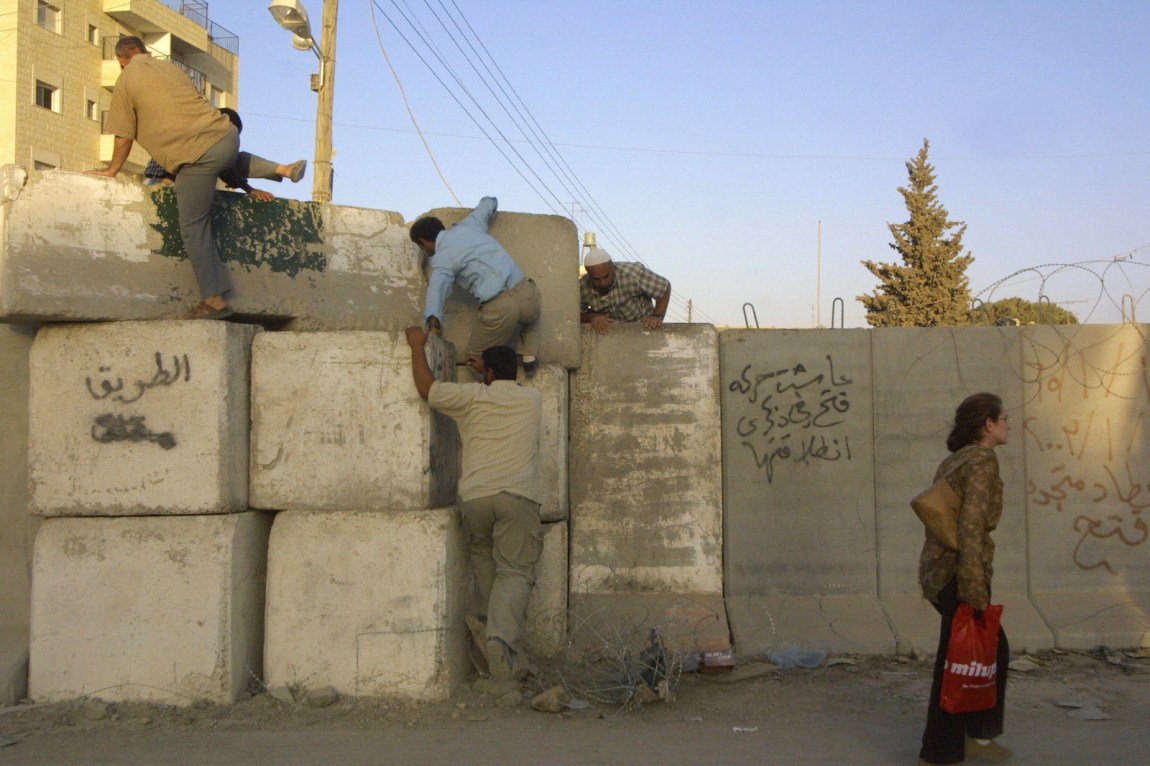At the start of last October over 200,000 Palestinians worked in Israel. Mostly they labored in construction and, to a lesser extent, in agriculture: leaving their homes in the morning, showing their work permits at checkpoints, building houses and roads, harvesting fruit and vegetables, then returning in the evening. At least 150,000 were from the West Bank, where wages are three times as low as in Israel; at least 18,500 were from Gaza, where wages were as much as ten times lower and more than half the population was unemployed. According to the International Labor Organization, an additional 35,000 West Bank Palestinians labored in the settlements.
This kind of work was a crucial pillar of support for the Palestinian economy. In 2021, under pressure from trade unions, the Palestinian Council of Ministers raised the minimum wage in Gaza and the West Bank, but it is still too low for most households to survive on, unless at least one member works in Israel or in the settlements. Over 20 percent of Palestine’s GNP derives from revenue earned in Israeli workplaces.
In response to Hamas’s October 7 attack, the Israeli government cut off this vital source of income. Within days, authorities had revoked the work permits of all Palestinians who commute to Israel for employment. Far-right members of Prime Minister Benjamin Netanyahu’s coalition threatened to resign if any were subsequently rehired. Faced with a sudden shortfall of low-wage labor in critical sectors, Netanyahu turned to a solution with a checkered history—importing migrant workers. In December, at the urging of the Israeli Builders Association, he approached Prime Minister Narendra Modi with a firm offer to admit up to 100,000 Indian workers. Modi immediately agreed, and earlier this month the first batch of more than sixty laborers arrived. As many as six thousand more are scheduled to get to Tel Aviv soon, on Israeli-subsidized charter flights.
Modi’s willingness to help Netanyahu should not be surprising. In recent years his Hindu chauvinist administration has emerged as a conspicuously loyal friend of Israel, reversing decades of policy in support of the Palestinian cause (at least in name, since India has also long maintained close ties with Tel Aviv). Indian nurses have been employed in Israel’s healthcare sector for several years; last May the two countries signed a memorandum to add tens of thousands of construction workers. Modi has now made good on that agreement. By greenlighting this wave of labor migration, he has thrown Netanyahu and his ministers a lifeline as they struggle within a trap of their own making: having committed to collectively punishing Palestinian workers, they know that Israel’s economy will find it hard to do without them.
*
Palestinian workers have been employed in Jewish settlements in what is now Israel since the early twentieth century. Early Zionist settlers, with scant experience in the manual labor of building, learned the trade from Arab stone masons, whose skills were venerated throughout the region. During the Ottoman Era these craftsmen had built palaces, hilltop villages, and township cores that are much admired today as examples of what the curator and scholar Bernard Rudosky called “architecture without architects.” In the Mandate period, and then again after 1948, their expertise was employed in cities like Jaffa, Haifa, Acre, Hebron, Nablus, Jerusalem, Bethlehem, and Tel Aviv. To this day, they remain the builders of choice on almost every construction site between the river and the sea. In other words, the economic destinies of Jewish settlers and Palestinians have long been interdependent, though always skewed to the benefit of the former. When I was researching Stone Men, my book on this topic, one Palestinian worker in Israel summed it up for me: “we build their houses, while they demolish our homes.”
Workers from the West Bank and Gaza have labored in Israel since both territories were occupied in 1967. They were intended to be a cheaper replacement for Israeli Palestinians, who at that time filled lower-wage jobs. The first batch of “returnees” from Gaza made the short commute from their refugee camps to Jaffa and Tel Aviv less than twenty years after they had been driven out in the other direction. In some cases, they were assigned to reconstruct and renovate buildings in their old neighborhoods or to work in orange groves once owned by friends or family members.
With few barriers to their movement, Palestinian workers soon became indispensable to Israel’s growth, enabling the state to build out the infrastructure needed to absorb millions of newly arrived Jewish citizens. Since Jewish Israelis expected to rapidly move up to higher-paid occupations, Palestinians served as a reserve army of cheap labor, available to fill the vacancies at the bottom tiers of the economy. During the first intifada (1987–93), Palestinian workers staged general strikes, including refusing to labor in Israel. In retaliation, authorities restricted their movement and tightened the permit system. To meet the resulting labor shortfalls, the Israeli government also issued temporary visas and permits of up to two years to migrant workers from Thailand and the Philippines. Tens of thousands followed, from countries in Eastern Europe and Africa.
Advertisement
The inflow spiked further after the Knesset revoked most of the Palestinian work permits during the second intifada (2000–05), citing “security threats” but with the additional intent of collective punishment. Soon there were as many as 300,000 foreign workers in Israel, or 12.5 percent of the labor force. By the early 2000s, an estimated 60 percent of them had overstayed their visas. Right-wing xenophobes, some in the government, drummed up a moral panic around the “demographic threat” these migrants posed to the country’s Jewish character. Between 2003 and 2005 authorities rounded up and deported as many as 145,000 of them.
But the need for migrant labor persisted, especially after Hamas came to power in 2007, at which point all workers from the Gaza Strip were cut off from their jobs inside Israel. By 2010 Israel was hosting as many as 250,000 foreign workers, at least half of them undocumented. Of those, 28,000 were Thai agricultural laborers, who often suffered grueling eighty-hour weeks working for ultralow wages. The government began to reauthorize permits to Gazan workers in 2019 and had issued 10,000 by 2021.
In the months before the Hamas attack, the Israeli government had been increasing the number of work permits, in part to alleviate the political tensions that resulted from mass unemployment in the Gaza Strip. On September 18, however, they closed the Erez crossing in response to protests by Palestinian youth along the border. The workers were let back into Israeli territory just nine days before October 7.
When their permits were subsequently rescinded, all of these Gazan laborers were stranded at their Israeli workplaces, ostensibly on suspicion of having aided the Hamas attack. Several thousand of them were deemed “illegal aliens” and detained without trial. Others fled to the West Bank, where the military tracked and incarcerated them. According to Human Rights Watch, the government held “thousands of workers in incommunicado detention for several weeks.” Many were beaten by guards during their captivity. In early November most were released and sent back to the Strip, into a war zone where they would be in mortal danger.
*
In 2017 Tel Aviv and Beijing signed an agreement to send six thousand Chinese construction workers to Israel to help address the housing shortage. Notably, Chinese authorities stipulated that workers should not be assigned to West Bank settlements, which are illegal under international law. By 2023 there were 30,000 Chinese laborers in Israel, many of whom fled after October 7, when more than fifty Thai guest workers were either killed or taken hostage by Hamas. Beijing subsequently signaled that it would not send replacements. Despite its economic ties with Israel, China has condemned the assaults on Gaza and reiterated its support for Palestinian statehood.
The Chinese government’s response is representative. While some countries from the global South, like Malawi and Kenya, have agreed to send agricultural workers to Israel, most have kept away. Even Arab nations that recently normalized relations with Israel demurred when asked to assist. After Netanyahu barred Palestinians from their jobs, he had the chutzpah to suggest that the United Arab Emirates cough up unemployment benefits for them. Sheikh Mohammed Bin Zayed gave a curt response:“Ask Zelensky.”
India is a glaring exception. The close ties between the two countries are rooted in bilateral trade: among other things, India is now the largest buyer of Israeli weaponry. In 2021 they formed an economic bloc—analysts call it the “West Asia Quad”—with the US, Saudi Arabia, and the UAE. There are also longstanding ideological commonalities between Hindutva and Zionism.1 Both hold that their nations should be built around the supremacy of a single religious and ethnic identity—a principle enshrined in Israel’s 2018 Basic Law, which stipulates that “the actualization of the right of national self-determination in the state of Israel is unique to the Jewish people.” Just as Israel has inexorably taken over land from historic Palestine, so India is now advancing settler colonialism in Kashmir.2 As for the heavily armed West Bank settlers, they are coming to resemble the paramilitary gangs of the Rashtriya Swayamsevak Sangh (RSS) that terrorize and even lynch Muslims across India.
Modi has tried to spin the migrant labor deal as proof of his administration’s rising standing on the world stage; banners at recruitment sites prominently displayed his picture. But the truth is much less impressive. He presides over a high-growth economy where professional and financial elites are enriched at the expense of the vast majority of the population who lack access to basic welfare services. His neoliberal policies have further intensified caste-based discrimination and class inequalities. For millions unable to make a living wage, especially in rural areas, where the agriculture economy is an advanced state of crisis, the opportunity to earn much higher pay in Israel—as high as five or six times local levels—is something of a godsend. Thousands of workers have applied for various positions—carpenters, blacksmiths, tilers, and plasterers—that were first advertised in Uttar Pradesh and Haryana, and now in Rajasthan, Bihar, and Telangana. Given the strong expectation that Israel will not admit Muslims, Modi will likely be sending Hindus only, a bias confirmed by Michelle Buckley and Paula Chakravartty’s report on the recruitment ads, some of which make explicit that only “Hindu workers” should apply.
Advertisement
For Modi’s critics, the gold rush to get to Israel only underscores his failure to generate decent jobs at home, even for the middle class—some of the applicants for construction work are college-educated. Despite his fierce crackdown on dissent and protest, ten labor unions publicly opposed the recruitment drive. Their joint statement noted that the plan to “export” workers “will amount to complicity on India’s part with Israel’s ongoing genocidal war against Palestinians and will naturally have adverse implications for Indian workers in the entire region.” The unions also drew attention to issues around worker safety. Due to its reliance on ultracheap labor, Israel’s construction industry has a high rate of onsite accidents—more than twice the EU average. This is doubly concerning because the guest workers heading to Israel do not receive any of the protections for insurance and medical coverage that the Indian government typically offers migrants going to the Gulf countries and elsewhere.
*
The Indian guest worker plan is reminiscent of another mass labor transformation from recent Middle Eastern history. In the 1950s and 1960s skilled Palestinian workers—either refugees from the Nakba or migrants seeking better employment opportunities—were recruited en masse to build the fast-modernizing states of the UAE, Saudi Arabia, Kuwait, and Qatar. But by the 1970s, as factions of the Palestine Liberation Organization (PLO) grew more militarily active, these workers turned into a liability because they, and other non-local Arab workers, harbored political views, including support for Palestinian liberation and pan-Arabism, that were unwelcome to the Gulf monarchies.3 The Gulf states thereafter turned to South Asia. Over time Indian, Nepalese, Pakistani, and Bangladeshi laborers came to dominate their workforces.
On the face of it, the prospect of a clean ethnic substitution along these lines might seem logical within Israel as well. But there are many reasons why it is unlikely. Israeli businesses have always preferred to employ Palestinian workers, with whom they often have longstanding relationships. Many Palestinians know some Hebrew and bring a degree of local know-how. The state, too, has reason to retain them. Unlike foreign migrants, they go back home each night, making few welfare demands. Rather than sending their wages to distant countries as remittances, they spend them locally on Israeli products that saturate their hometown markets.
In the West Bank, employing Palestinian laborers also advances the project of settlement. In the long term, as Leila Farsakh has documented, inducting Palestinians into Israeli wage labor has resulted in a shift away from subsistence agriculture, leading some farm owners to neglect their smallholdings.4 That inattention, in turn, makes it easier for the Israeli authorities to expropriate the properties as “state land” and more likely for Palestinians to directly sell settlers the plots that no longer provide enough revenue. Just as importantly, the permit system has long served as a mechanism to quell Palestinian resistance. Workers lose their much-prized documents if they or any family members are suspected of activity deemed political in nature—demonstrating, for example, or throwing stones at soldiers. Over the years, authorities have dangled an increase in permits for “good behavior” and canceled them in response to insurgent conduct.
In sum, the advantages of employing Palestinians have, so far, outweighed the benefits of importing foreigners. Whether that will change now depends on the outcome of infighting among factions of the Israeli political class. The military establishment, still wedded to using work permits for pacification, has pushed for the reemployment of Palestinian workers. Yet the far right is holding firm. One compromise has been to approve the return of 10,000 workers to factories in West Bank settlements, where production had ground to a halt. Settler kingpins like National Security Minister Itamar Ben-Gvir and Finance Minister Bezalel Smotrich publicly opposed the decision but privately approved this boost to the settlement economy, as Jonathan Shamir has reported.
Inside the Green Line, business owners hit hard by the embargo have pushed back against the exclusion policies. Dan Catarivas, president of the Israeli Federation of Bi-National Chambers of Commerce, declared that “the majority of employers are generally in favor of the return of Palestinian workers.” In the meantime, loopholes can always be found. By the end of March at least 2,400 Israeli businesses had managed to wrangle exemptions for such “humanitarian purposes” as reemploying Palestinian workers in hotels, bakeries, and furniture companies.
*
The entry checkpoints may eventually be reopened for West Bank workers. But what kind of future lies ahead for those in Gaza? Israel has destroyed so much of the Strip’s infrastructure that few viable sources of livelihood remain. Most of the population may be living in tents for years to come. At the time of writing, the specter of starvation stalks the land and the Israeli government threatens a renewed assault on South Gaza—things may get worse still.
Unlike the Promised Land of the West Bank (officially designated as “Judea and Samaria” by Israel), where swathes of the Jordan Valley are falling daily under the control of settlers, Gaza is not theologically significant in the Zionist imagination. But that may not be enough to save it from a large-scale land grab. The far right has renewed its plans to return settlements to the Strip, whose commercial allure has not gone unnoticed either. Jared Kushner recently made headlines when he noted that “Gaza’s waterfront property could be very valuable,” stoking the fantasies of developers about seaside condos—to be built, presumably, by Palestinians.
According to the doctrine of Labor Zionism, Jewish settlers who toiled on the land between the river and sea earned the right to own it. Yet there has been no equivalent reward for the Palestinian laborers who built so many of Israel’s houses, schools, factories, offices, museums, roads, bridges, and even its separation wall. For more than a century they have effectively been migrant workers in their own land; their sweat has earned them not equity but disenfranchisement, displacement, and poverty.
No one in their position should have to earn rights by hard labor alone. But nor should their long record of toil be discounted. When the time comes to restore the civil and political rights of Palestinians, and to repair for past injustices, the contributions of working people should not be overlooked. As a laborer at a Green Line checkpoint once said to me, “I’ve been building homes every day over there for thirty years. In a way, it’s really my country too, isn’t it?”






